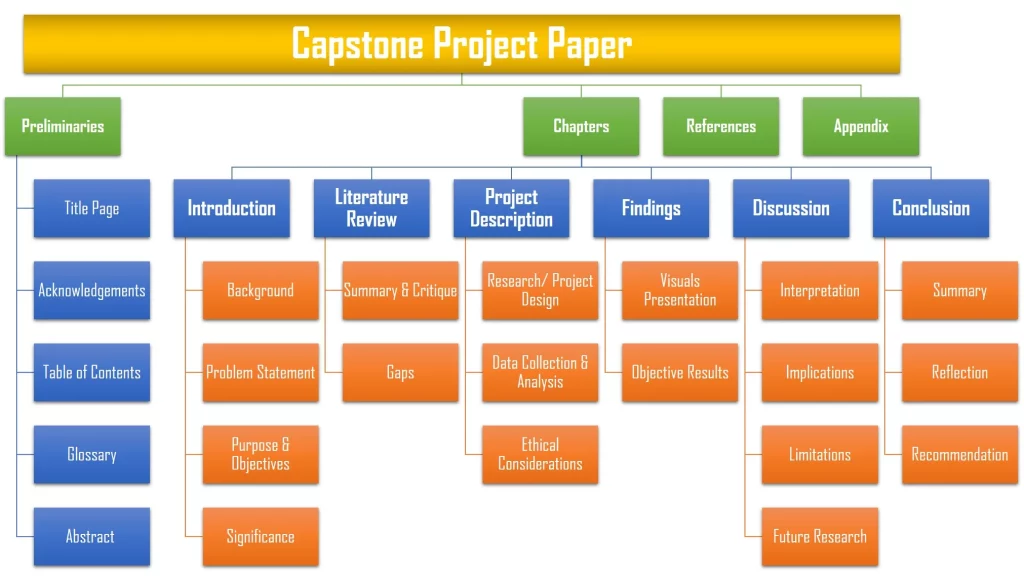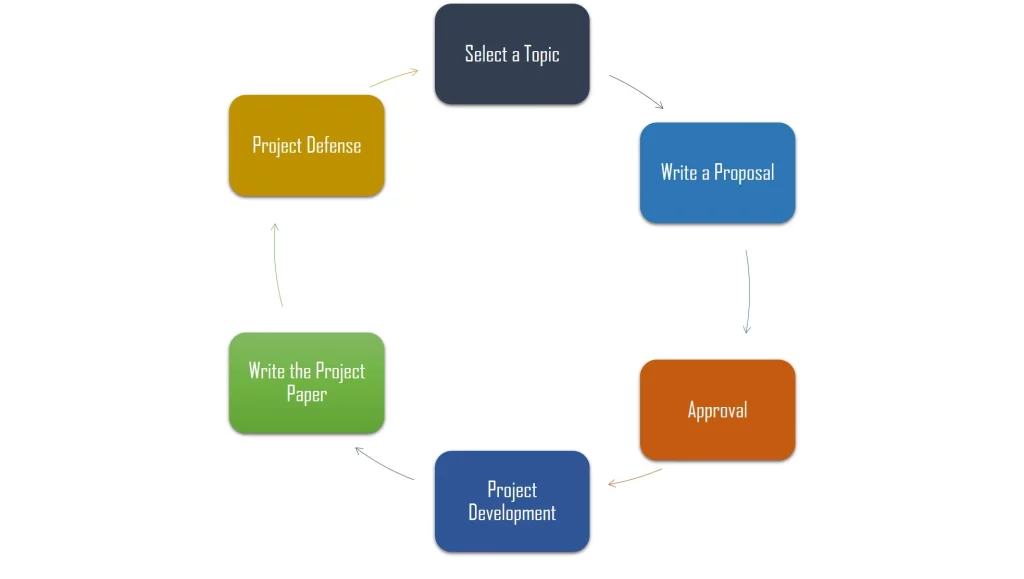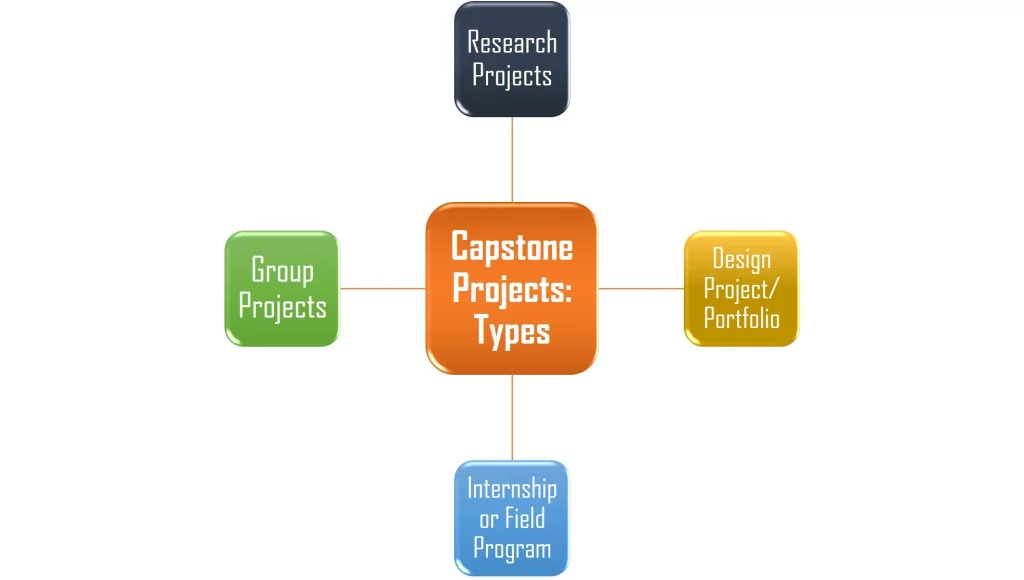
A capstone project is a multifaceted assignment that serves as a culminating academic and intellectual experience for students, typically undertaken during their final (senior) year of study or as part of a degree program’s requirements. The purpose of a capstone project is to integrate and apply the knowledge and skills gained throughout the course of a student’s academic journey. It often involves independent research, critical thinking, problem-solving, and the demonstration of proficiency in a chosen field of study.
Here are sample capstone projects for students:
Sample Sports Management Capstone Project Paper
Key Characteristics
- Integration of Knowledge: Bringing together the various concepts, theories, and skills acquired during the academic program.
- Application of Skills: Applying theoretical knowledge to practical situations or real-world problems.
- Independent Research: Conducting original research or in-depth analysis under the guidance of a mentor or advisor.
- Demonstration of Competence: Showcasing the student’s mastery of the subject matter and their ability to synthesize information.
- Presentation: Communicating findings and insights effectively through written reports, oral presentations, or other mediums.
- Reflective Component: Often includes a reflective element where students discuss their learning experiences and personal growth.
Capstone projects can vary widely in format and scope depending on the academic discipline, institution, and specific requirements of the program. They are common in undergraduate and graduate education and are designed to prepare students for the challenges they may face in their future careers or further academic pursuits.
Capstone Project Process

The stages of a capstone project process can vary based on the academic institution, specific program requirements, and the nature of the project. However, a generalized overview of the typical stages involved in a capstone project includes the following:
- Topic Selection:
- Capstone Proposal Development:
- Approval:
- Portfolio/Project/Product Development:
- Write the Capstone Project Paper:
- Write a Reflection:
- Defense/Oral Presentation:
Format of a Capstone Project Paper: Key Components
- Title Page:
- Approvals Page: Official approvals from advisors or faculty members.
- Acknowledgements: Express gratitude to individuals or institutions that contributed to the project.
- Table of Contents: List of sections and subsections with corresponding page numbers.
- List of Tables/Glossary:
- Abstract:
- Introduction Chapter:
- Literature Review Chapter:
- Methodology/Project Description Chapter:
- Findings Chapter:
- Discussion Chapter:
- Conclusion Chapter:
- References:
- Appendices:
It’s important for students to check the specific guidelines provided by their institution or program regarding formatting requirements, citation styles, and any additional elements that may be required. Adhering to these guidelines ensures the capstone project paper meets the necessary academic standards.
4 Most Common Types

Capstone projects can take various forms depending on the academic institution, the specific program, and the field of study. Here are the 4 most common types of capstone projects:
- Research Project:
- Internship or Field Program:
- Design Project (Portfolio):
- Group Project:
These four main types represent common structures for capstone projects, each emphasizing distinct aspects such as research, practical application, design, and collaborative teamwork. The specific type chosen often aligns with the goals and requirements of the academic institution and the program of study.
Who Writes a Capstone Project?
Capstone Projects in Various Academic Levels
Here is a detailed breakdown of how the expectations vary for different educational levels:
- High School Seniors:
- College Seniors (Undergrad/Bachelors):
- Masters Students:
- Doctoral Students:
The degree of independence and the complexity of the project increase as students progress from high school to doctoral levels. At each level, the capstone project serves as a significant academic milestone.
Common Disciplines
Capstone Projects in Business
Capstone Projects in Computer Science & Information Technology
Capstone Projects in Engineering
Capstone Projects in Nursing
Other Notable Areas for Capstone Projects
- Accounting:
- Architecture:
- Arts:
- Criminal Justice:
- Education:
- Environmental Science:
- Healthcare Administration & Management:
- Marketing:
- Occupational Therapy:
- Political Science:
- Project Management:
- Psychology:
- Public Administration:
- Public Health:
- Science & Technology:
- Social Work:
In each of these disciplines, capstone projects serve as a platform for students to demonstrate their mastery of the subject matter, apply theoretical knowledge to practical scenarios, and showcase their problem-solving and critical thinking skills. Additionally, these projects often involve a significant research component, and students may collaborate with industry partners or professionals in their respective fields. The goal is to provide a comprehensive and integrative learning experience that prepares students for the challenges they may face in their future careers.
Steps: How to Write a Final Capstone Project Paper
- Understand the Guidelines: Review the specific guidelines provided by your institution and program. Understand the requirements, formatting, and any specific elements expected in the capstone project.
- Choose a Relevant Topic: Select a topic that aligns with your academic interests, program requirements, and the scope of the capstone project. Ensure it is feasible within the given timeframe and resources.
- Conduct a Literature Review: Review existing literature related to your chosen topic. Summarize key findings, identify gaps, and provide a theoretical foundation for your project.
- Develop a Research Question or Problem Statement: Clearly articulate the research question or problem your capstone project aims to address. This should be the guiding focus throughout your paper.
- Plan Your Methodology OR Project Design:
- Create a Project Proposal:
- Data Collection and Analysis OR Design the Project:
- Draft the Introduction Chapter:
- Write the Literature Review:
- Detail the Methodology:
- Present Your Findings:
- Discuss Your Results:
- Draft the Conclusion:
- Compose the Abstract: Write a concise abstract that summarizes your capstone project, including the research question, methodology, key findings, and conclusions.
- Create a References Section: Compile a comprehensive list of all sources cited in your capstone project. Follow a specific citation style (e.g., APA, MLA) as required by your program.
- Add the Appendices:
- Review and Revise:
- Finalize Your Paper:
Remember to consult with your advisor or mentor at each stage of the drafting process for guidance and feedback. Following these steps will help you create a well-structured and academically sound capstone project paper.
Frequently Asked Questions (FAQS)
-
Capstone Project vs. Thesis Paper?
While both involve original research, a capstone project is typically more applied, emphasizing practical solutions to real-world problems. It often includes a tangible component like a product or program. A thesis paper, on the other hand, is an extensive academic document focused on in-depth research and theoretical contributions.
-
Capstone Project vs. Research Paper?
Capstone projects integrate theoretical knowledge with practical application, often emphasizing real-world solutions. Research papers, while scholarly, tend to focus more on academic exploration and analysis of a specific topic without the applied component found in capstone projects.
-
How do I choose a suitable topic for my capstone project?
- Consider your interests, career goals, and the relevance to your field.
- Identify a specific problem or gap in knowledge that you’re passionate about addressing.
- Consult with advisors, peers, and professionals for input.
- Ensure the chosen topic aligns with the scope and requirements of your capstone project.
-
What are the key components of a successful capstone proposal?
- Problem Statement: Clearly articulate the problem or research question your project aims to address.
- Objectives: Outline specific, measurable, and achievable goals for your project.
- Methodology: Describe the research design, data collection methods, and analysis techniques.
- Significance: Explain the importance and potential impact of your project.
- Feasibility: Demonstrate that your project is realistic within the given time and resource constraints.
-
Are there specific guidelines for conducting research for my capstone?
- Follow ethical guidelines relevant to your field.
- Adhere to your institution’s research policies.
- Choose appropriate research methods and tools based on your research question.
- Document your research process thoroughly for transparency and replicability.
-
What resources are available to support me in my capstone project?
- Utilize academic databases, libraries, and online resources for research.
- Seek guidance from professors, mentors, and librarians.
- Access workshops or training sessions provided by your institution.
- Collaborate with peers or professionals who may have expertise in your field.
-
How do I effectively present my capstone project to an audience?
- Structure your presentation with a clear introduction, methodology, findings, and conclusion.
- Use visual aids such as slides, graphs, and charts.
- Practice your presentation to ensure clarity and adherence to time limits.
- Be prepared to answer questions and engage with your audience.
- Tailor your presentation style to the expectations of your audience, whether academic or professional.
-
What are some tips for managing time and resources during my capstone work?
- Develop a realistic timeline with clear milestones.
- Prioritize tasks based on their importance and deadlines.
- Regularly communicate with your advisor to ensure you are on track.
- Utilize project management tools and techniques.
- Be prepared to adapt your plan as needed and seek support when facing challenges.
-
How can I ensure my capstone project aligns with my major or field of study?
- Choose a topic that directly relates to the core concepts and goals of your major or field.
- Align your project objectives with the learning outcomes of your program.
- Seek input from faculty members to ensure your project aligns with academic standards.
-
What role does reflection play in the context of a capstone experience?
- Reflection allows you to assess your learning, identify challenges, and consider alternative approaches.
- Regularly reflect on your progress, decision-making processes, and the overall impact of your capstone project.
- Use reflection to improve your project and enhance your personal and professional growth.
-
Are there opportunities for interdisciplinary approaches in capstone projects?
- Many institutions encourage interdisciplinary approaches in capstone projects.
- Collaborate with students or professionals from different disciplines to bring diverse perspectives to your project.
- Consider how insights from multiple fields can enrich your research and solutions.
-
How can I balance the demands of my capstone project with other commitments?
- Develop a realistic schedule that accounts for your other commitments.
- Communicate your project requirements and time constraints with peers, family, and employers.
- Prioritize tasks and focus on the most critical elements of your project.
- Seek support from your network to manage stress and workload.
-
What are the common challenges students face in capstone projects, and how can they be overcome?
- Common challenges include time management, research constraints, and unexpected issues.
- Plan ahead, seek support from advisors, and be adaptable to changes in your project plan.
- Regular communication with your project team or advisor is crucial for overcoming challenges.
-
How do I measure the success of my capstone project?
- Success can be measured by achieving project goals, contributing to knowledge or practice, and receiving positive feedback from advisors and stakeholders.
- Evaluate how well your project aligns with its intended outcomes and addresses the identified problem or research question.
-
Are there specific technologies or tools recommended for capstone research?
The specific technologies or tools recommended for capstone research depend on the nature of the project, the field of study, and the goals of the research. However, here are some general categories of tools and technologies that are commonly used across various disciplines for capstone research:
- Data Analysis and Statistics:
- Statistical Software: Tools like SPSS, SAS, or R are often used for quantitative data analysis.
- Data Visualization: Platforms like Tableau or Python libraries like Matplotlib and Seaborn are used to create visual representations of data.
- Programming and Software Development:
- Programming Languages: Depending on the project, languages such as Python, Java, C++, or others may be used for software development.
- Version Control: Tools like Git are essential for managing and tracking changes in code.
- Project Management:
- Project Management Software: Tools like Asana, Trello, or Microsoft Project can help organize tasks and timelines.
- Collaboration Tools: Platforms like Slack or Microsoft Teams facilitate communication and collaboration among team members.
- Documentation and Writing:
- Document Processing: Word processors like Microsoft Word or LaTeX for scientific and technical writing.
- Reference Management: Tools like EndNote, Zotero, or Mendeley help manage and cite references.
- Survey and Data Collection:
- Survey Tools: Online survey platforms like SurveyMonkey, Google Forms, or Qualtrics for collecting data.
- Data Collection Apps: Mobile apps for field data collection, depending on the nature of the research.
- Geospatial Analysis:
- GIS Software: Geographic Information System (GIS) tools like ArcGIS or QGIS for spatial analysis and mapping.
- Simulation and Modeling:
- Simulation Software: Tools like MATLAB, Simulink, or specialized software for modeling and simulation in engineering and science projects.
- Healthcare and Laboratory Tools:
- Electronic Health Record (EHR) Systems: For healthcare-related projects.
- Laboratory Information Management Systems (LIMS): For managing and tracking laboratory data.
- Database Management:
- Database Systems: Platforms like MySQL, PostgreSQL, or MongoDB for managing and querying large datasets.
- Presentation and Communication:
- Presentation Software: Tools like Microsoft PowerPoint or Google Slides for creating and delivering presentations.
- Communication Tools: Video conferencing tools for virtual presentations and meetings.
It’s crucial for students to familiarize themselves with the tools relevant to their specific field of study and project requirements. Additionally, staying updated on emerging technologies and tools in the respective fields can enhance the quality and efficiency of capstone research.
- Data Analysis and Statistics:
-
What are the real-world applications of the concepts learned in my capstone project?
The real-world applications of the concepts learned in a capstone project vary depending on the specific field of study and the nature of the project. However, here are some general examples across different disciplines:
- Business and Marketing:
- Market Analysis: Techniques learned in a business capstone project, such as market research and competitive analysis, can be applied to real-world scenarios for informed decision-making.
- Strategic Planning: Strategic planning skills developed in a business capstone can be applied to develop and execute business strategies in a professional setting.
- Computer Science and Information Technology:
- Software Development: Programming and software development skills acquired in a capstone project can be applied to develop applications, software systems, and solutions in the tech industry.
- Cybersecurity: Capstone projects focused on cybersecurity can contribute to securing computer systems and networks in various industries.
- Engineering:
- Product Design and Prototyping: Engineering capstone projects often involve designing and prototyping products, with applications in industries ranging from manufacturing to consumer electronics.
- Sustainable Solutions: Projects addressing environmental sustainability can contribute to the development of eco-friendly practices in engineering projects.
- Healthcare and Nursing:
- Patient Care and Management: Nursing capstone projects focused on patient care can enhance healthcare delivery and management practices.
- Healthcare Informatics: Projects in healthcare informatics can contribute to the development and improvement of health information systems and technologies.
- Education:
- Curriculum Development: Education capstone projects focusing on curriculum design and development can be directly applied to create effective teaching materials.
- Instructional Design: Skills in instructional design acquired during a capstone project can be applied to design engaging and effective learning experiences.
- Social Work and Psychology:
- Community Interventions: Capstone projects in social work may involve designing and implementing community interventions, with direct applications in social services and community development.
- Counseling and Therapy Techniques: Psychological interventions and counseling techniques learned in a capstone project can be applied in real-world therapy sessions.
- Public Administration and Policy:
- Policy Analysis: Capstone projects in public administration often involve policy analysis, which can be applied in government agencies or non-profit organizations to inform policy decisions.
- Program Evaluation: Evaluation skills developed in a capstone project can be applied to assess the effectiveness of public programs and initiatives.
- Environmental Science:
- Conservation Strategies: Environmental science capstone projects may involve designing and implementing conservation strategies, with applications in protecting natural resources.
- Environmental Impact Assessment: Skills in assessing the environmental impact acquired in a capstone project can be applied in industry or government to ensure sustainable practices.
The key is for students to leverage the practical skills and knowledge gained during their capstone projects to address real-world challenges in their respective fields. The applications are diverse, reflecting the interdisciplinary nature of capstone projects and their relevance to professional settings.
- Business and Marketing:
-
How can I adapt to unexpected challenges that may arise during my capstone work?
- Maintain flexibility in your project plan to accommodate unforeseen challenges.
- Seek guidance from your advisor or project team when facing unexpected issues.
- Use setbacks as opportunities for learning and improvement.
-
What are the benefits of collaborating with peers in a capstone project team?
- Collaboration brings diverse perspectives and skills to the project.
- Teamwork allows for more comprehensive solutions and can enhance creativity.
- Shared responsibilities distribute the workload and provide a support network for overcoming challenges.
-
How long should a capstone project paper be?
- The length of a capstone project paper varies but is typically around 20-40 pages.
- Follow the specific guidelines provided by your academic institution and program for the required length.
In conclusion, the key to writing a successful capstone project lies in a combination of careful planning, thorough research, effective communication, and the ability to demonstrate the application of academic knowledge to real-world scenarios. Essential elements include selecting a relevant and compelling topic, formulating clear objectives, conducting rigorous research, and presenting findings in a structured and coherent manner. Additionally, consistent reflection, adaptability to challenges, and collaboration with peers or mentors contribute to a successful capstone project. Successful projects often address a specific problem, provide practical solutions, and showcase the student’s academic and professional growth.
